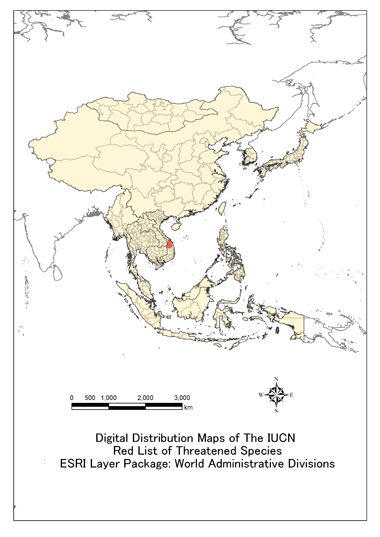
TOP > 生物多様性センターの国際協力 > ESABII > Database > Threatened Mammal Species Database > Pygathrix cinerea

Pygathrix cinerea
Taxonomy (Name)
| Class | MAMMALIAIUCN | |
|---|---|---|
| Order | DIPROTODONTIAIUCN | |
| Family | DIPROTODONTIAIUCN | |
| Scientific Name | Pygathrix cinereaIUCN | |
| Author | Nadler, 1997IUCN | |
| Synonyms | Pygathrix nemaeus Nadler, 1997 ssp. cinerea IUCN | |
| Common Name | Grey-shanked Douc Langur, Gray-shanked Douc LangurIUCN | |
| Local name | Brunei Darussalam | |
| Cambodia | ||
| China | ||
| Indonesia | ||
| Japan | ||
| Lao PDR | ||
| Malaysia | Lotong Kelabu | |
| Myanmar | ||
| Mongolia | ||
| Philippines | ||
| Singapore | ||
| Republic of Korea | ||
| Thailand | ||
| Vietnam | ||
Picture
Distribution, Range
This species occurs in central Viet Nam, in Quang Nam, Quang Ngai, Binh Dinh, Kon Tum, and Gia Lai provinces (Nadler et al. 2003; Ha Thang Long 2004).
Map


Country
| Brunei Darussalam | |
|---|---|
| Cambodia | |
| China | |
| Indonesia | |
| Japan | |
| Lao PDR | |
| Malaysia | |
| Myanmar | |
| Mongolia | |
| Philippines | |
| Singapore | |
| Republic of Korea | |
| Thailand | |
| Vietnam |
Status
International Status
IUCN Red List Category
CRIUCN
Justification
Listed as Critically Endangered as the population is declining at over 80% in the entire distribution range due to several threats, and the decline is predicted to continue at the same rate or slightly higher in the next 30-36 years (approximately three generations).
CITES
CMS
National Status
| Country | Category | Reference |
|---|---|---|
| Brunei Darussalam | ||
| Cambodia | ||
| China | ||
| Indonesia | ||
| Japan | ||
| Korea | ||
| Lao PDR | ||
| Malaysia | ||
| Mongolia | ||
| Myanmar | ||
| Philippines | ||
| Singapore | ||
| Thailand | ||
| Vietnam |
Ecology Discription
Appearance
Habitat
This species occurs in evergreen and semi-evergreen primary and highly degraded forest.
Population size
The total population for this species is estimated at 550 to 700 individuals, but some areas with assumed occurrence are not yet surveyed (Ha Thang Long 2004).
Behavior
Diet
Like the other doucs, Pygathrix cinerea is largely arboreal and mainly folivorous, though plant buds, fruit, seeds, and flowers are also taken (Nadler et al. 2003).
Reproduction
Threat
Major Threat(s)
The Viet Namese Central Highland forests where these animals occur lose almost 10,000 ha of forest annually due to logging and agricultural conversion. This creates a progressively more fragmented habitat and population structure. Additionally, they are hunted for food, traditional "medicine" (for example it is used in the preparation of "monkey balm"), and for sale as pets (Ha Thanh Long 2004). Their behavioural responses to hunting, hiding motionless in the canopy rather than fleeing, make them more vulnerable (Nadler et al. 2003); they also become susceptible to snaring when they come to the ground to move in degraded habitats.
Conservation and Measurement
International
This species is listed in CITES Appendix I. IUCN
National
This species is listed on Appendix 1B of Decree 32 (2006) in Viet Nam. IUCN
Conservation law
| Country | Status | Reference |
|---|---|---|
| Brunei Darussalam | ||
| Cambodia | ||
| China | ||
| Indonesia | ||
| Japan | ||
| Korea | ||
| Lao PDR | ||
| Malaysia | ||
| Mongolia | ||
| Myanmar | ||
| Philippines | ||
| Singapore | ||
| Thailand | ||
| Vietnam | Group I: Prohibiting Exploitation and Use for Commercial Purposes | The Government Decree 32/2006/ND-CP, Dated 30th March 2006 on Management of Endangered, Precious and Rare Species of Wild Plants and Animals |
Protected Area
The species occurs in several protected areas in Viet Nam, especially Song Thanh, Ngoc Linh, Kon Kai Kinh, and Kon Cha Rang; however, protection against hunting and habitat disturbance is not completely enforced (Ha Thanh Long 2004).
Other Coservation Projects
A long-term study in Gia Lai Province included in the ?Viet Nam Primate Conservation Program? of the Frankfurt Zoological Society is currently in place (Ha Thanh Long 2004), and additional surveys in the distribution area are also included in the program, which may perhaps identify new populations. There is an ongoing captive-breeding program for this species at the Endangered Primate Rescue Center at Cuc Phuong National Park in Viet Nam, which also incorporates an education component.
Citation
Groves, C. P. 2001. Primate taxonomy. Smithsonian Institution Press, Washington, DC, USA.
Ha Thanh Long. 2004. Distribution and status of grey-shanked douc langur (Pygthrix cinerea) in Vietnam. In: T. Nadler, U. Streicher and Ha Thang Long (eds), Conservation of primates in Vietnam, pp. 52-57. Frankfurt Zoological Society, Hanoi, Vietnam.
Lippold, L. and Vu Ngoc Thanh. 1995. Douc langur variety in the central highlands of Vietnam. Asian Primates 5(1-2): 6?8.
Lippold, L. and Vu Ngoc Thanh. 1999. Distribution of the grey-shanked douc langur in Vietnam. Asian Primates 7(1-2): 1-3.
Lippold, L. and Vu Ngoc Thanh. 2002. The grey-shanked douc: survey results from Tien Phuoc, Quang Nam, Viet Nam. Asian Primates 8(1-2): 3-6.
Nadler, T. 1995. Douc langur Pygathrix nemaeus ssp. and Francois? langur Trachypithecus francoisi ssp. with questionable taxonomic status in the Endangered Primate Rescue Center, Vietnam. Asian Primates 5(1-2): 1, 8-10.
Nadler, T. 1997. A new subspecies of Douc langur, Pygathrix nemaeus cinereus ssp. nov. Zoologische Garten 4: 165-176.
Nadler, T., Momberg, F., Nguyen, X., Dang and Lormee, N. 2003. Leaf monkeys: Vietnam Primate Conservation Status Review 2002 part 2.
Roos, C. and Nadler, T. 2001. Molecular evolution of the Douc Langurs. Zoologische Garten 71(1): 1-6.
